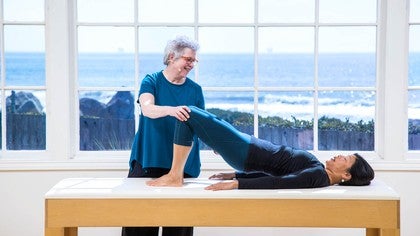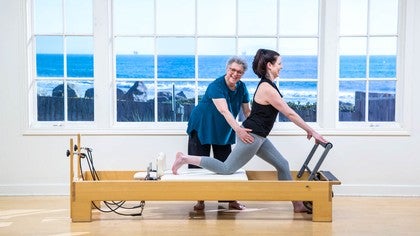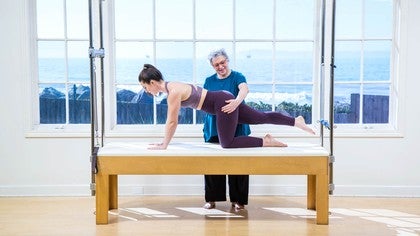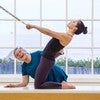Description
About This Video
Transcript
Read Full Transcript
We're gonna look at this tutorial about the quadriceps and the deep quadriceps start at the femur. And you have the latter. Alice vastus, lateralis, vastus, medialis, and vast, I'm sorry, MIDI Alice here, and vastus intermedius Alice. On top of that, you have your rectus fi, fam Morris, and they comes from here and it comes all the way down to the patella. You also have your Satorius, which comes here and attaches here. And that's kind of what they called the either the tail or knee, or that's what brings the leg up into a passe. So looking at Michelle, first of all, just let's just sit a second. No, you're perfect. But I want you to just wa look at her alignment, because sometimes that's gonna teach me where they're over strong or over tight.
And you can see that right now her knees are out this way. So I'm going to go to put in my brain. Maybe this is tight and pulling her here. So what I want her to do is I want her to pick her leg up and turn her leg in, and then just let it hang. She has a little bit. What I have is not neatness, but we're, we'll work on that.
And so here is again the vastus MIDI Alice, the vastest inner medialis and the lateral lateralis. And what I want to watch her is I want her to give me neutral spine. There we go. And let's watch her straighten her left knee. Now what's happening is this lateral part is really strong. You can see that it's pulling out.
She's also using the top of her erectus for Morris, which is pulling her hip backwards. So I want her to stay in neutral, I want her to bring her knees together and I'm going to tap the she could tap. Tapping is great because it kind of puts the brain there and let's see if you can think of as you straighten your leg, it comes right in line and I'm going to tap. There we go. Now I don't want you right now to come all the way straight so her brain goes here and then that way. So I would rather go and her ankle foot needs to be in line.
That's gray. And if you put your hand here, you will feel a little better tone on the medial portion of it. So we want to look for balance of the quadricep around that and gray and a little less. There's, okay. So we're going to look at this eventually in footwork cause a lot of times our clients are over activating here. This really important, you know it's great for a karate kick but it's not, it's, we just need to get it more specific down there. Now we're going to look at the hamstrings and all the hamstrings attach to the sip bone. The bicep for Morse comes to the medial part of the leg.
Then you have your semi men Brosius, which comes down to the lateral leg. And then on top of that is your CMA to gnosis. That also comes to the tibia. The same issue we're going to look at is when there's an imbalance. So you can see I'm lifting it.
Maybe there's too much overwork on the lateral portion compared to the medial portion. So I'm going to have Michelle lie prone on her back belly. I'm sorry. And so remember this, the hamstring attaches here and if I think about it here, I want her to visualize that she could slide her sip bone closer to her knee. There she goes. It's very subtle. And what you will see activated down. Yes there is. You're going to see a little bit better definition.
This is called her gluteal fold. Now already again, if you can see she is a little wide, so I'm gonna also say, Oh well is there overwork of the lateral hamstring? It could be the lateral quadriceps, it could be the iliotibial band. So I'm going to ask her abduct her legs, IPP, and I'm going to watch her bend her right knee. There we go again. If I feel the tone, it's a little bit more lateral, so I'm just going to give her that information and let's have her do that again. Go ahead and I'm just directing her so that it gets well aligned.
There we go. Now I want a straight, you're going to send your sip bone down so the, there you go. And I want her to lift her leg up and then lower down. Now she does a pretty good job, but a lot of our clients are weak here and they'll do a strategy of lifting, but they're bending more at this part of the hamstring and we want to get that feeling of lifting from there. That's it. There you go. And then lower down. Now lie on your back for me please. And Ben both knees again, the same issues coming up that this is where she wants to live.
And so that's your new place.
And this is more how the hamstrings are working in a standing and walking. There is a whole bridging that you do articulating. We will teach you how to articulate, but it's all staying into the hamstrings. So we're gonna look at the importance of the hamstrings in, um, bridging which relates to standing. I'm also gonna do a simple exercise of a muscle testing.
So I'm going to act as her to pull her heel down. That's it. That's fine. Now she wants to do extra. She wants to use that hip flexor. So if you put your hand on the belly and she just lightly pulls down lightly. Thank you. Thank you. She wants to use this pull down. No, don't. You're doing this as well. So you just pull your heel down.
There you go. So that will wake up the hamstring. So her goal, and you could also do a bring both legs up. So here her sip phones are fixed. Pull your heels down. I her pulling the heels towards her sip bones in bridging. It's reversed. Your feet are fixed and I want her to bring her sip phones forward over feet bridge up.
Now a lot of people, when they bridge down, if they're doing articulating, they get so interested in shortening, it kicks out the back of the leg and that neutral spine is really important in getting that lateral leg. So you're going to bridge up. There you go. Good. Lightly. Squeeze me. Good. Now reach your sit bones out the window and slowly come down. Squeeze me, squeeze me. There we go. She's still using her hip flexors. So here's the image and she said she drives.
You have to drive in California. Your sit bones are headlights and they're in low B. Yes. Now you're gradually going to go into high beam as you bridge up. So squeeze me. Okay, the sip bones are going to beam up. Yes ma'am. There we go. Now go to high beam. Out your knees.
Squeeze, squeeze. There you go. And now you're gradually drawing the high beam to the middle beam, to the low beam. More low beam. Go more low beam. And there we go. And that's her hamstrings.
So we want to create a balance and we're going to do an exercise. It's going to train the quad, and then the hamstrings. What I'm doing is I'm putting my hand behind her. I'm going to also bring in another muscle group that is not, I didn't, haven't done a draw. It's called your Papa Ts. It comes here and right now she's a little over-rotated, so she's gonna lightly pull her heel back to the table.
She's going to give a lit in. It's tiny spray pull back. Now she's going to slowly straighten her knee. She's going to keep a little that rotation. Very good. Very good. Give me more neutral spine. No. Yes. Up forward on your pubis. There you go.
So neutral spine is about her hip points being lined with our pubis. It's kind of subtle. I don't know if you say she's just a slight back and I'm want to get that out of the picture and then pull back, pull back, pull back and now go forward. There we go. Yes ma'am. That's great. And she's doing a much better job. You can see now she's able to straighten it, pull back and I'm really giving a little more attention about that medial portion of the leg and then come back and now watch her leg hang and you can see it's falling better down. Okay.
So the great thing about this exercise is also your clients can do it at home. We'll do the other leg together. So Leslie's also knock knee. So I might swing my leg forward and swing it back and just getting that going and then just let it, Hey, so I do this a lot before maybe my workout, you know, footwork cause I always have this leg alignment. So now we're going to look at, um, putting this, how it relates to the reformer work, foot work and then in standee. So we're going to look at how the quadriceps and the hamstrings come into work.
And a lot of problems, uh, I see in footwork is you see clients use momentum and they go into hyperextension and then they come back or they're, they're changing their pelvis as they're doing it. And as you get their pelvis quieter, you're going to get them to use their legs in a whole different way. I'm going to put the mini between her legs and we're going to start at the arches. Um, and so what I want to, uh, do with Michelle is I'm going to keep breaking, stopping or in the middle of the movement to keep her out. So a lot of times it's so easy on the reformer to tuck and especially when your client doesn't understand their legs well enough, they'll tend to go to their hip flexors and their back. So let's watch what Michelle does.
So she's doing to push out one third hole stay. She's going to let her back say wide and long. And I might even put my hands here just to feel observed the tone. Then she's going to push out a little more hold and I'm watching her femoral fold so that I don't see it. She talk and she, it doesn't look like a lot of work, but she's has to stay in her legs a lot. She's going to push out a little more great hole and then she's going to go out more. Keep going, keep going. There we go. Hold.
I can almost feel it's very subtle with her. I could feel her tailbone go up and then this started soften, so the more she stays in neutral, she'll get to this balance of the medial and the lateral. Push out a little more. There we go. There we go. And wonderful. And then she's going to slowly come back in and she's going to come back all the way home. Just breathe through your sit bones.
Let your hook your sit bones down to the table. Yep. Your sit bones are back in the low beam. There you go. You're going to keep it in low beam as you push out.
And then she's going to come back in all the way and come back in. Now I'm gonna have her goat to a wide second and she can go turned out. I'm just want to see first some, I don't want to, uh, see what she does in bridging. But push out first.
So if this is working, it's going to take the work away from her hamstrings. Great. There we go. Now I want her to get her spine longer into the shoulder rest. She might even give me a little bit of extension of her upper thoracic. Very good. She's going to make her femur heads. Lift her pelvis up. She wants to talk and I want her to get right under that gluteal fold.
Sip bones bridge up. Come on, come on. [inaudible] yep, yep, yep, yep, yep. Lift. Lift. She needs a little right side higher. It's very subtle. There you go. And then you're gonna lower down and she's going to stay in those hamstrings. And then you're going to come back in and come back in all the way.
There you go. Now push out again for a, she did a pretty good job. Push out. If you put your hands here or your clients here, tuck your tail under, you will feel it loosen up. So that's why it's really important to be in neutral. And this is so important for standing work of having that lateral leg working. Now come in and put your arches on the thing again.
So the, the beauty about thinking about the quadriceps is the quadriceps support in front and the hamstrings come in back. So my image is that we're going to have like a saran wrap around the knee so that it's going to feel more supported front and back. So I want to talk about the hamstrings because if, when I'm in hyperextension that backline is in too much length. So I want to control the, the length of the hamstring and then it also will keep me into the quadricep. So we're gonna think about the front and the back working together.
So the sit bones are in low beam and you're going to push out. There you go. Keep going. But you're going to imagine there's a little support behind the knee as well. She's going to bridge up, don't talk, get longer. Lift up. Thank you. There you go.
And then you're going to lower the whole thing down and then she's going to decelerate and use the hamstrings in the quads together. And what I'm always looking at is when I see that femoral folk kind of close up, then I know that there's going to be an imbalance in the quad in the hamstrings. So we want to get that supported on two on three sides. Now we're going to look at this in elephant, and again, we did this in bone rhythms, but sometimes finding it in standing is also great for your client to see. So come up to elephant. We're going to do neutral elephant.
That's great. That's it. Now. Well remember we just talked about having a balance between the hamstrings and the quads and so she's going to push out with her legs whole just so I want her to always have the carriage out just a bit. She's going to bend her knees and so I want her to send her sip phones up to the ceiling and pull up through the quad. She's going to straighten your legs because those quads are lifting. But she there, she did a great job.
What you see a lot of times bend your knees is press bad version. Hyper extend. Go ahead. So do you see she slammed the knees backwards and what I'm really kind of imaging is here's her greater trocanter I'm going to in there. Can I lift the thighbone straight up towards the ceiling and get the structures around the bone to lift straight up. So we're going to talk a lot about this because in my own way in elephant is close chain and it's a different coordination than open chain.
So like let's say legs and straps is more open chain. How we coordinate in standing. The way the bones are designed is very different and it's really important to be teaching our clients this. And I'm going to say from my own experience with knee injuries, I really need to be doing lots more close chain. So this tutorial was very much about the front and the back of the leg.
The next tutorial will be about the lateral leg, the outside leg, and the doctors. Thank you.
Embodied Anatomy: Lower Body
Comments
You need to be a subscriber to post a comment.
Please Log In or Create an Account to start your free trial.









